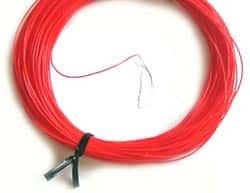Recent advancements in wireless technology may have led many people to believe that soon, we would be able to do away with these squiggly, snaking, long implements we call wires. However hard we may try to hide them by burying them within walls and under the ground, the time is not yet ripe for a life entirely without wires. While we have to put up with wires all around us, it would be interesting to know something more about them.
Use of wires can be broadly categorized into two main classes of requirements – mechanical and electrical. While the mechanical requirements deal mainly with load carrying strength/capacity of the wire under use, the electrical requirements can be further subdivided into power and signal carrying capabilities. In this article, we will be talk about wires and their electrical requirements only. The materials with which wires are made, their dimensions and the nature of protection used depends to a large extent on whether the wire is required to carry power or signal.
Most wires within our houses and those carrying power are made of copper. Conductivity, malleability and cost are the main considerations that govern the choice. Copper is a good conductor of electricity, meaning it presents a low resistance to the flow of electricity through it. The metal is easy to bend and mold in the form of wires of different diameters. Since copper is abundantly available, the price is reasonable for residential use. Some wires are made of aluminum, which is cheaper than copper. However, its conductivity is lower than that of copper. For carrying the same amount of electricity, you need an aluminum wire with a larger diameter compared to that of a copper wire.
The nature of protection used on wires carrying electrical power depends on the voltage it is carrying and the environment in which the wire is used. For example, special cladding and fire-retardant protection is required for wires carrying high voltage electricity passing through an area with plenty of oil.
Compared to power handling wires, signal-carrying wires are of more varied types, depending on the application. For example, there can be connecting wires, RF coaxial feeders, screened cables, ribbon cables, data cables and many more. For most of these applications, the governing factor is the frequency of the signal rather than the voltage and current carrying capacity. Waveform distortion, crosstalk, noise and signal loss are more important rather than the amount of power transferred.
As long as the signal frequency is low, say below 1000 Hz or so, the material or construction of the wire does not matter greatly. However, as the frequency of the signal increases, the wire starts to behave like a non-linear entity and its inherent inductance and capacitance start to cloud its performance. With still higher frequencies, the signal is unable to retain its original waveform. To retain the high-frequency performance, people need to use special types of RF coaxial feeders, ribbon cables, screened cables, etc.
For example, to prevent loss of signal in screened cables, a low-loss insulator often surrounds the wire conductor. A braided sheath on the outside of the insulator acts as a shield and a PVC jacket protects the entire package.

